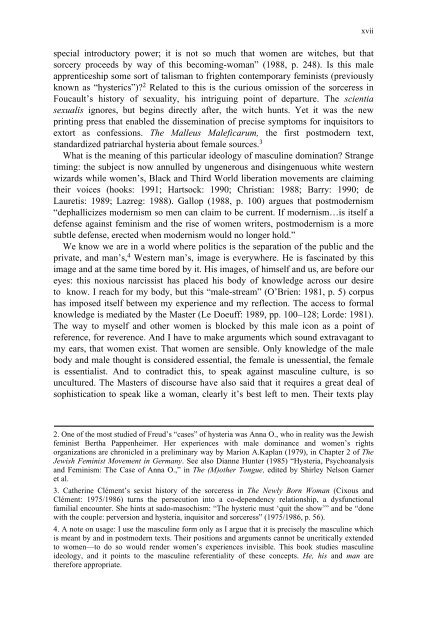Nothing Mat(t)ers: A Feminist Critique of Postmodernism
Nothing Mat(t)ers: A Feminist Critique of Postmodernism
Nothing Mat(t)ers: A Feminist Critique of Postmodernism
You also want an ePaper? Increase the reach of your titles
YUMPU automatically turns print PDFs into web optimized ePapers that Google loves.
xvii<br />
special introductory power; it is not so much that women are witches, but that<br />
sorcery proceeds by way <strong>of</strong> this becoming-woman” (1988, p. 248). Is this male<br />
apprenticeship some sort <strong>of</strong> talisman to frighten contemporary feminists (previously<br />
known as “hysterics”) 2 Related to this is the curious omission <strong>of</strong> the sorceress in<br />
Foucault’s history <strong>of</strong> sexuality, his intriguing point <strong>of</strong> departure. The scientia<br />
sexualis ignores, but begins directly after, the witch hunts. Yet it was the new<br />
printing press that enabled the dissemination <strong>of</strong> precise symptoms for inquisitors to<br />
extort as confessions. The Malleus Maleficarum, the first postmodern text,<br />
standardized patriarchal hysteria about female sources. 3<br />
What is the meaning <strong>of</strong> this particular ideology <strong>of</strong> masculine domination Strange<br />
timing: the subject is now annulled by ungenerous and disingenuous white western<br />
wizards while women’s, Black and Third World liberation movements are claiming<br />
their voices (hooks: 1991; Hartsock: 1990; Christian: 1988; Barry: 1990; de<br />
Lauretis: 1989; Lazreg: 1988). Gallop (1988, p. 100) argues that postmodernism<br />
“dephallicizes modernism so men can claim to be current. If modernism…is itself a<br />
defense against feminism and the rise <strong>of</strong> women writ<strong>ers</strong>, postmodernism is a more<br />
subtle defense, erected when modernism would no longer hold.”<br />
We know we are in a world where politics is the separation <strong>of</strong> the public and the<br />
private, and man’s, 4 Western man’s, image is everywhere. He is fascinated by this<br />
image and at the same time bored by it. His images, <strong>of</strong> himself and us, are before our<br />
eyes: this noxious narcissist has placed his body <strong>of</strong> knowledge across our desire<br />
to know. I reach for my body, but this “male-stream” (O’Brien: 1981, p. 5) corpus<br />
has imposed itself between my experience and my reflection. The access to formal<br />
knowledge is mediated by the Master (Le Doeuff: 1989, pp. 100–128; Lorde: 1981).<br />
The way to myself and other women is blocked by this male icon as a point <strong>of</strong><br />
reference, for reverence. And I have to make arguments which sound extravagant to<br />
my ears, that women exist. That women are sensible. Only knowledge <strong>of</strong> the male<br />
body and male thought is considered essential, the female is unessential, the female<br />
is essentialist. And to contradict this, to speak against masculine culture, is so<br />
uncultured. The Mast<strong>ers</strong> <strong>of</strong> discourse have also said that it requires a great deal <strong>of</strong><br />
sophistication to speak like a woman, clearly it’s best left to men. Their texts play<br />
2. One <strong>of</strong> the most studied <strong>of</strong> Freud’s “cases” <strong>of</strong> hysteria was Anna O., who in reality was the Jewish<br />
feminist Bertha Pappenheimer. Her experiences with male dominance and women’s rights<br />
organizations are chronicled in a preliminary way by Marion A.Kaplan (1979), in Chapter 2 <strong>of</strong> The<br />
Jewish <strong>Feminist</strong> Movement in Germany. See also Dianne Hunter (1985) “Hysteria, Psychoanalysis<br />
and Feminism: The Case <strong>of</strong> Anna O.,” in The (M)other Tongue, edited by Shirley Nelson Garner<br />
et al.<br />
3. Catherine Clément’s sexist history <strong>of</strong> the sorceress in The Newly Born Woman (Cixous and<br />
Clément: 1975/1986) turns the p<strong>ers</strong>ecution into a co-dependency relationship, a dysfunctional<br />
familial encounter. She hints at sado-masochism: “The hysteric must ‘quit the show’” and be “done<br />
with the couple: perv<strong>ers</strong>ion and hysteria, inquisitor and sorceress” (1975/1986, p. 56).<br />
4. A note on usage: I use the masculine form only as I argue that it is precisely the masculine which<br />
is meant by and in postmodern texts. Their positions and arguments cannot be uncritically extended<br />
to women—to do so would render women’s experiences invisible. This book studies masculine<br />
ideology, and it points to the masculine referentiality <strong>of</strong> these concepts. He, his and man are<br />
therefore appropriate.

















